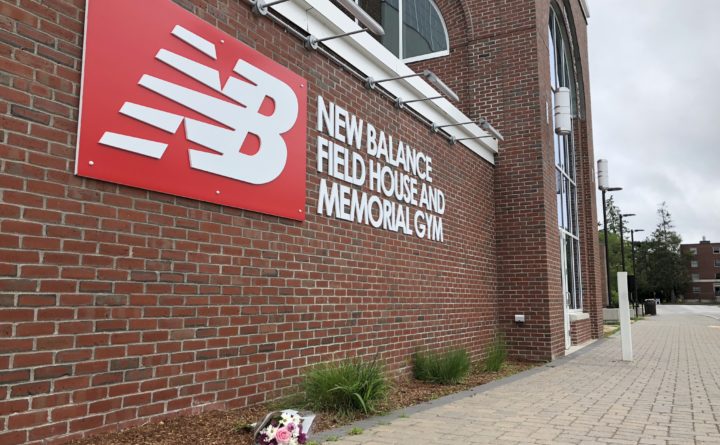Sudden Heart Failure Top Cause of Nontraumatic Death for College Athletes

Callie Ferguson | BDN - A bouquet a flowers lie on the ground near the doorway of the New Balance Field House at the University of Maine on July 25. The previous day, 18-year-old football player Darius Minor collapsed and died during a preseason workout on the Orono campus field.
The fatal collapse of a University of Maine football player during a workout in July was the result of a rare medical tragedy that is the No. 1 nontraumatic cause of death in college athletes.
The Maine medical examiner’s office ruled that 18-year-old Darius Minor died July 24 from aortic dissection with cardiac tamponade, a heart condition that is considered uncommon, especially among younger men. Hypertension, or high blood pressure, was listed as a contributing factor.
Only about 1 in 50,000 young athletes dies from sudden cardiac failure, according to the Mayo Clinic. Even so, sudden cardiac death is the most common nontraumatic (not caused by accident or injury) cause of death among college athletes, according to the NCAA, the governing body that oversees UMaine’s Division I football team.
In response, a movement to explore how cardiac issues in athletes are handled is gaining momentum within the college sports community.
However, the first sign of a heart problem often is the fatal event itself, said Dr. Tracy Bras, a sports medicine physician at Eastern Maine Medical Center in Bangor.
In 2014, the NCAA held a summit to discuss ways to prevent sudden heart failure. A task force later issued guidelines on improving how athletes are screened as well as outlining how to respond if an athlete suddenly experiences apparent heart problems. The recommendations, published in the Journal of the American College of Cardiology, stressed the importance of a comprehensive pre-participation physical and the development of a well-rehearsed emergency response plan.
UMaine spokeswoman Margaret Nagle said the university’s sports participation policies reflect the NCAA’s updated guidelines.
“The published recommendations from that summit have been reviewed and help to guide university screening practices,” she said.
It isn’t possible to analyze how those policies were applied to Minor’s case because the university has declined to discuss his specific medical condition and history, citing confidentiality laws.
UMaine’s policies have not changed since Minor’s death, Nagle said, but they will continue to be reviewed annually in accordance with updates from the NCAA. The latest guidelines recommend schools follow one of two screening models, which UMaine does.
Like all incoming UMaine student athletes, Minor was required to undergo a pre-participation physical with the Black Bears’ team doctor, which he passed, head coach Joe Harasymiak said.
UMaine uses a screening that includes evaluation for high blood pressure, according to Nagle.
Minor was also required to submit a medical questionnaire where he was asked to list his medical history, including any heart problems, and he passed a physical from his doctor in Virginia.
On the humid afternoon he died, Minor was just 15 minutes into light supervised practice when he tapped a coach on the shoulder and said he felt like he was going to pass out, Harasymiak said. After he lost consciousness, the team’s training staff, followed by EMTs, were unable to resuscitate him.
The NCAA’s 2016 recommendations emphasize that a “written emergency action plan for treatment of cardiac arrest that is rehearsed” can be an area where schools can save lives.
“Our emergency action plans state how to react to the situation to cardiac arrest or other medical emergencies along with staff being trained as professional rescuers,” Nagle said. “Nothing has changed [in the past month]; however, we will constantly review policy and procedure.”
Bras, who wasn’t aware of Minor’s specific case but spoke generally about the field of sports medicine, said policies evolve with the “deep underlying motivation” to improve wellness and safety.
But even when an athlete passes all the required screenings, “in so many of these cases, a lot of the time the presenting symptom of these conditions is sudden cardiac death,” Bras said.
“That is just an unfortunate fact,” she said.
Story Credit: https://bangordailynews.com/2018/08/27/news/bangor/how-umaine-screens-athletes-for-heart-disease/
Since you’re here, we have a small favor to ask. Requests from schools and districts for our screening services are growing, which means that the need for funds to cover the cost of those services is also growing. We want to make our services available to those who request it and beyond, so you can see why we need your help. Safebeat heart screenings take a lot of time, money, and hard work to produce but we do it because we understand the value of a child's life, PRICELESS!
If everyone who reads this likes it and helps fund it, our future would be more secure. For as little as $1, you can support Safebeat and it only takes a minute. Make a contribution. -The SafeBeat Team


